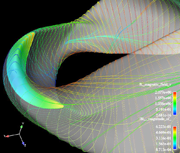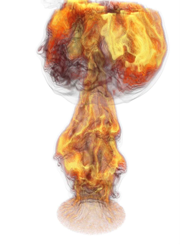Flow Techniques
Virtually all of our stakeholders' simulations model the transport of matter or energy. The resulting vector fields appear in output files in several forms like velocity, momentum, and flux. Existing vector field methods - ranging from glyph-based techniques for direct representation to streamlines, streamribbons or particle advection for indirect representation - have proven to be useful in limited situations (e.g., coarse, 2D grids) but are not so practical for use on large-scale, time-varying models. Our work focuses on meeting specific stakeholder requirements:
- combustion stakeholders have requested line-integral convolution on manifold surfaces to convey a visual representation of a flow field on an isosurface;
- astrophysics stakeholders modeling neutrino transport have requested techniques to display radiation flux where each grid point contains an array of values representing flux at specified energy spectral values or departure angles;
- AMR-based data from codes in fusion, environmental management, accelerator, and climate modeling pose special challenges (momentum conservation, continuity, etc.) at the boundaries of hierarchical grid patches;
- accelerator modeling codes produce discrete, particle-based data consisting of millions individual points having an associated momentum as well as fields from PIC grids - these stakeholders are in need of effective techniques to visually analyze large and complex vector fields; and
- fusion stakeholders are interested in locating and analyzing the formation and evolution of eddies in magnetic fields - our project will explore effective techniques combining topological-based vector field analysis with vector field display to provide new capabilities in this area.
See Gallery: Turbulent Flow
|

Fusion vector field visualization.

Complex aerodynamic vortex breakdown in a single time step of a delta wing data set.

Pool fire simulation
|














